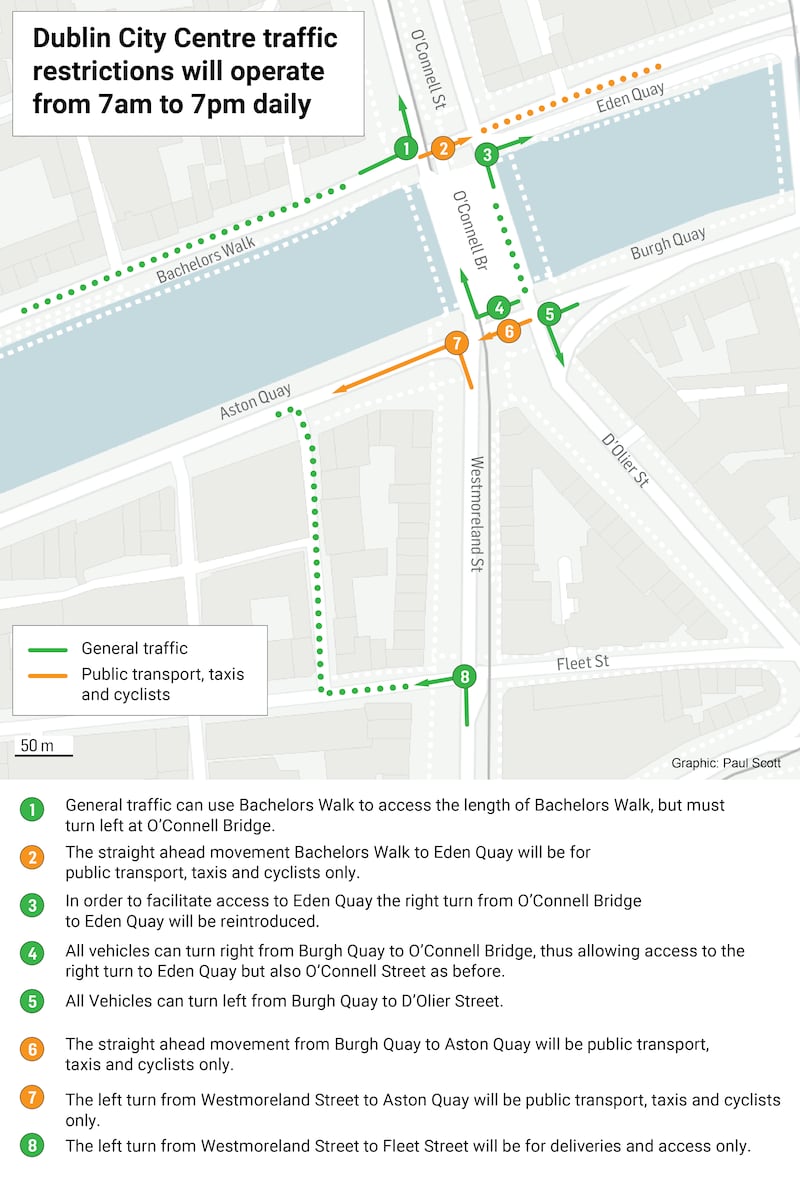Traffic restrictions introduced less than two weeks ago in Dublin city centre are already paying dividends for public transport users, with bus passengers appearing to be the biggest beneficiaries of reduced congestion on the Liffey quays.
Private cars and commercial vehicles have been banned from travelling directly east or west along the Liffey at either side of O’Connell Bridge from 7am to 7pm daily since August 25th.
On the north quays, cars and commercial vehicles on Bachelors Walk have to turn left on to O’Connell Street and cannot go straight ahead on to Eden Quay towards Dublin Port. Private traffic is already banned from turning right from Bachelors Walk on to O’Connell Bridge to head to the south of the city.
On the southside, motorists are not permitted to drive straight from Burgh Quay to Aston Quay. The left turn from Westmoreland Street to Aston Quay is also restricted to public transport and cyclists only.
READ MORE
All of the city’s car parks remain accessible, and motorists will still be able to cross any Liffey bridge currently open to cars. The measures are part of the Dublin City Centre Transport Plan, the aim of which is to “remove traffic that has no destination in the city”, with 60 per cent of motorists currently passing through rather than stopping in town.
It also aims to significantly increase the reliability of bus services and create a “reduced traffic environment” in the city ahead of the expansion of the BusConnects plan and the construction of the MetroLink rail line.
While the new measures are still in the bedding-in phase, Dublin Bus chief executive Billy Hann says there was an instant improvement for bus services using the quays.
“Early indications are very positive,” he says. “The quays are flowing really well. We have a number of inspectors out there every day who are monitoring what’s going on, and I’ve been there myself, and from my own perspective ... early indications are very good.”

The restrictions were introduced in the last week in August, when traffic in the city is typically low, and there was an expectation that congestion could worsen when September hit.
However, Mr Hann says this has not materialised. “We all expected in the first few days traffic would be light, but I was down there myself this Monday morning and afternoon and it was no different than it had been in the week when it was introduced.”
He cautions that this is purely an observational and anecdotal perspective. Dublin Bus will be collating data over the coming months to make a more informed assessment of the measures that it will present to a Dublin City Council working group.
“Every one of our buses is tracked all over the city so we can determine how quickly they are moving, or not moving, and we will be able to compare the time it takes for a bus to get from one end of the quays to the other, post the changes versus pre the changes,” he added.
Dublin Bus will also assess whether the restrictions on the quays are having any unwanted effects on bus times in surrounding areas.
“We will need to look at where the traffic is being dispersed to and if it’s having an impact on other areas,” Mr Hann said. “We don’t have the data to determine that yet, but certainly from our drivers who are out there on the routes we’re not hearing that there’s anything negative at all at the moment.
“If there if there are unintended consequences in other arteries we may have to look at that, and look at the sequencing of lights and see how that’s working for bus priority.”
Bus inspectors on the quays noted in the early stages that noncompliance by private motorists was “reasonably high”, but this “has been improving day on day”, and it is hoped this will die out as the weeks go on.
For Bus Éireann, the initial indications for its bus routes using the quays have also been positive.
“While it is too soon to accurately analyse [or] compare route data, anecdotally our drivers have reported quicker travel times through the area since the measures were implemented on 25 August,” it said in a statement.
The company says it welcomes the restrictions on private vehicles and is advocating for “increased bus prioritisation across the public transport network”.
Taxi drivers, who are also exempt from the restrictions, have similarly noted improvements in journey times on the quays.
“It’s much better for taxi drivers, [the quays] are clear now, it’s brilliant,” driver Paul May says.
Another taxi driver, Michael McCarthy, had similar experiences. “Going down the quay is a lot easier. I get from Christchurch to O’Connell Bridge in about four minutes which I never did.”

However, he has noticed increased traffic on the streets off the quays. “It’s a little bit slower if I have to go to Parnell Street, and it’s a little bit slower if I have to go to Dame Street, but down the quays I’m flying. It’s a bit of give with one hand, take with the other,” McCarthy added.
Some delivery drivers and tradespeople using the quays over the last week have had a less enthusiastic response to the measures.
Declan Sheelan, who was making deliveries on Eustace Street, just off the south quays in Temple Bar, on Tuesday described the new plan as a “disaster” for people who need to access the city centre.
“It sets your whole day back about 45 minutes to an hour,” he says. “It’s a disaster coming into the city and out of the city, but once they keep all the tourists happy that’s the most important thing.”
Liam Kilfoyle, who provides services for pubs, said the measures would deter tradespeople from taking jobs in the city.
“Trying to get into town now for a small operator will probably take him another extra hour, and the costs will escalate then for the guy who’s looking for the plumber or the carpenter,” he says.
If the restrictions had been limited to the weekend, they could have been implemented across many more streets, he said.
“I think they should close off the city from 7pm on a Friday till 7am on a Monday, so business could be done during the week and have everyone walking around [at the weekend] which is great.”
John Young, a wholesale butcher supplying hotels and restaurants, supports the measures. “Personally it’s suiting me, because it suits the round that I have to do,” he says. “The traffic is moving. We do both sides of the Liffey and a lot of traffic has come off the quays.”

But Wojciech Korzan, who delivers fish to restaurants in the city centre, has had a tougher time getting around.
“I do understand traffic restrictions but they should help delivery drivers as well,” he says. “On Capel Street you can go in up to 11am – that should be the solution. That’s my point of view. This is a touristic city and we need to supply the food for tourists, especially fish and chips.”
- Sign up for push alerts and have the best news, analysis and comment delivered directly to your phone
- Join The Irish Times on WhatsApp and stay up to date
- Listen to our Inside Politics podcast for the best political chat and analysis














